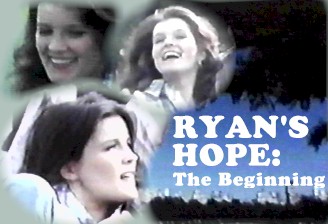About a year ago, this magazine initiated a series of articles that explored the merits of the various daytime television serials. In past issues we reviewed The Young and The Restless, Days of Our Lives, Love of Life, General Hospital, and The Edge of Night. After those first five articles, we somehow got sidetracked by one thing or another, and we temporarily suspended the series. But readers have urged us to reinstate this popular feature of our magazine. With the support and assistance of the shows involved, we hope to continue presenting these critical looks into the field of serial drama from time to time in the future. Meanwhile, this month: Backstage at RYAN'S HOPE By JON-MICHAEL REED Click here to see pictures related to this article To the occasional soap opera viewer, it may seem as though nothing ever happens on serials; that a plot situation does not change from one week to the next, one month to the next, or even one year to the next. And that's partly true: basic situations on serials rarely change all that much over a long period of time. For example, Jane is after Joe who's married to Betty, and Jane's been trying to break up that number for what seems like an unreasonable length of time. But what the occasional viewer often misses are the varying steps Jane must climb in order to reach her goal -- not to mention all the lateral, conflict-causing steps that must be taken by Joe and Betty. This, after all, is the stuff that soaps are made of: not a multitude of changing goals and over-all situations for a character, but the day-to-day evolution of a multitude of situations within one basic situation in which any one character and any one group of characters find themselves. Related to this is the fact that for all intents and purposes, time doesn't exist in the world of soap opera. Or rather, time is a flexible commodity that can be either stretched ad infinitum or jettisoned ahead without regard to chronology. Whichever way the writers of a soap opera decide to use the element of time, you'd better believe that a regular viewer demands a steady diet of involvement in order to sustain interest. Basically, there are two things a serial writer must do to secure this steady audience involvement. He must devise constantly intriguing plot developments (the conflicting steps taken toward a specific goal), and he must create characters within these developments with whom the audience can somehow empathize; characters with whom the audience can be so concerned about, so interested in, so "hooked" on, that they'll turn on that television dial as often as possible. Since Ryan's Hope premiered on ABC in early July, the fictional story time has, more or less, paralleled actual time. The writers of the show seem to be working; in the "stretched out time" tradition of soap operas. Events that have taken place on screen, in other words, could conceivably progress at the same pace as they might in actual fact. This would be all well and good except for the absence of the two important elements necessary to sustain audience involvement -- intriguing plot developments and characters with whom the audience can empathize. In launching the show, 'the writers came up with an interesting idea on how to "hook" an audience, In the first episode, Frank Ryan,' the hero, or at least one of the heroes on the show, was shown tumbling down a flight of stairs. He was put in a hospital bed, and there he remained, in a coma, for over two months. This was the essential story premise for that amount of time, and the writers developed what they supposedly assumed would be an intriguing development -- was Frank's fall down the stairs an accident, or was he pushed by someone? An intriguing "mystery" in itself, the premise might have worked except that one could have cared less what happened to Frank Ryan. The audience knew practically nothing about Frank except for second-hand reflections of those who "loved him" -- his family and friends. This was second, hand empathy for a character, because the audience never saw, except for occasional flashbacks, what the man was like. An audience can't be presumed to care about someone they don't see "in the flesh," in action, doing something good (or even bad) that will enable the audience to decide for itself whether this is a character worth the attention. Therefore, the "mystery" didn't work. The intrigue the audience was supposed to feel for this man's dilemma -- including whether or not he was taking bribes or was unfaithful to his wife, etc. -- was also given to the audience second-hand. All of Frank's actions were seen in retrospect, and' the audience, therefore, was more concerned with the fates of other characters in the story. Unfortunately, the fate of almost every other character was also tied up with Frank's. And since Frank's fate was not really dramatically intriguing -- at least in terms of the soap opera format -- it was rather difficult to sustain interest in those characters. The ones who perhaps attracted more interest -- Bucky and Faith and Nell, Ed, and Seneca -- were not related to Frank's fate. But again, the writers devised "mysteries" about these people's lives that strangely missed the need for steady audience involvement. I say strangely, because I'm not at all sure why. Perhaps it's because my taste in intrigue relies on some advance information that will help me solve the mystery. I still have no clue, at this writing, why Faith continually rebuffs Bucky's even most innocent advances. Also, I never had a clue that the real reason Dr. Nell left her husband Dr. Seneca and decided to do research on her own was because she had a terrible disease. And I felt somewhat cheated when that revelation ultimately came, because the writers had led the audience to believe that her decision to leave her husband was purely emotional; that she wanted to do something, achieve something, in her own right, rather than follow on the coattails of her more famous husband. Thankfully, it seems as though the show is finally getting on its feet. The little mysteries that were meant to intrigue but which only frustrated have, for the most part, been revealed. Stories with active plots, not stagnant situations, are being told. Now, after three months of waiting for the proverbial "something to happen," the audience is able to witness characters involved in attempts to resolve problems and conflicts with which the audience can actively empathize. The audience is being Allowed to see a character through the audience's eyes and not through another character's.
It's about time, because the characters on Ryan's Hope are basically wonderfully appealing. There's a nice balance in the grand soap opera tradition between "them that has, and them that hopes to get"; between rich and poor, WASP and ethnic. Perhaps the most appealing aspect of Ryan's Hope is the strong sense of family among the Ryans. This kind of relationship is not unique in soap-land, but their individuality is. An especially well-chosen cast contributes enormously to this individuality. The specific qualities the actors bring to their roles (with minor exceptions) are impeccably tuned. If we didn't have a Kate Mulgrew, a Bernard Barrow, or a Helen Gallagher (as Mary, Johnnie, and Maeve Ryan, respectively) commiserating with Frank's condition, there would have been absolutely no reason to endure Frank's recovery. The production credits on this show are also outstanding, with special mention to Sy Tomashoff's sets and Carey Gold's music. And now that the writers seem to have settled down to writing stories rather than merely presenting situations, Ryan's Hope shows every indication of moving into the totally outstanding class. |
|
© 1975 Lamplight Enterprises, Inc. [Daily TV, Volume 4, No. 1 - January 1976] |


